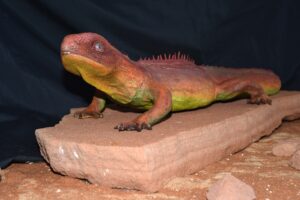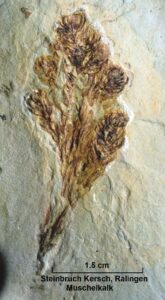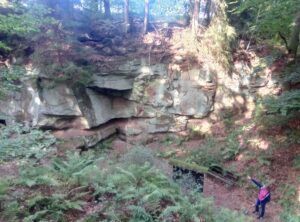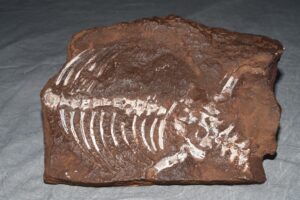Introduction
In 1904, local quarrymen discovered the articulated remains of a dog-sized reptile (preserved length is 22 cm) on a dark red-brown sandstone slab in a quarry at Oberbettingen near Hillesheim (Nature- & Geopark Vulkaneifel, Germany). This unique find from the Upper Buntsandstein (Early Triassic, early Anisian, Kyllburg beds) was soon obtained by the local amateur paleontologist Stefan Dohm in Gerolstein, who sent the fossil to Prof. Dr. Ernst Jaeckel for investigation. In the same year, Jaeckel (1904) described the partial skeleton as a new genus and species and called it Eifelosaurus triadicus. The white bones are relatively well preserved. The articulated skeleton is about 60% complete, with the torso and parts of the tail and limbs present. The living animal would have been 50 to 60 cm long (Fig. 1). Jaeckel thought the reptile to be an early lizard but later workers (e.g., Huene 1929; Sander & Gee 1994) saw it otherwise, and Huene (1929) assigned the genus with some confidence to the rhynchosaurs.

Figure 1. Reconstruction of Eifelosaurus triadicus Jaeckel, 1904, exhibited in the Natural History Museum in Gerolstein.
Research history
There are only a few papers about Eifelosaurus triadicus. The first was the original article by Jaeckel (1904), who described the type specimen. Huene (1929) revised Jaeckel’s classification and proposed a systematic position within the rhynchosaurids rather than the lizards. Later on, the specimen disappeared. According to Krebs (1969), the fossil remained in the collection of Stefan Dohm in Gerolstein. Unfortunately, this collection was destroyed during World War II, when Gerolstein suffered heavy damage by allied bombers in 1944. However, the Eifelosaurus was fortunately relocated before the destruction (probably after the death of Dohm in 1924) and re-emerged in the collections of the Steinmann Institute in Bonn (Sander & Gee 1994). These authors discussed Eifelosaurus and the few other vertebrate finds from the Buntsandstein in the Eifel, together with a review of the flora and paleoecology of the region in the Lower Triassic. A short note about Eifelosaurus can also be found in Ezcurra et al. (2016), who regard the reptile as a potential early Anisian rhynchosaur and stated that no further studies have been conducted to determine its affinities. According to them, Eifelosaurus would be the oldest of the three known European representatives of Anisian rhynchosaurs, which on a global scale had their main distribution in the Karoo Basin of South Africa with a further occurrence in the Moenkopi Formation of the southwestern USA. The potential for future research appears to be high, and Ezcurra et al. (2016) noted that some undescribed contemporary rhynchosaur material may be present in Germany.
In the Triassic, rhynchosaurs were widely distributed. They are usually easily recognizable by their skull, characterized by a protruding beak (Sander & Gee 1994) used in their herbivorous feeding. In the case of Eifelosaurus, the main problem for a successful systematic assignment is the unknown skull anatomy of the holotype. Additional preparation, coupled with a modern revision of the type specimen might add some further clues. However, according to Sander & Gee (1994), a well-preserved skull would be needed to clarify the systematic position of Eifelosaurus. Unfortunately, no other specimens were found later and a revised determination will have to wait until new material becomes available. This will be difficult that no active quarries in the area of the type locality exist. Even so, modern quarrying would likely not produce more finds because it would need old-style handwork to uncover such rare fossils in the usually more or less sterile sandstones of the Buntsandstein. Another problem could be the unknown exact location of the original quarry (Jaeckel 1904 did not specify a type locality) and the position of the bed in which the reptile has been discovered. There are numerous small and now abandoned quarries in the Kyllburg beds of the Upper Buntsandstein in the area south of Oberbettingen that were used to fulfill local needs for building material, like floor slabs, facades and building stones. The cultural database of Rhineland-Palatinate refers to those quarries (Fig. 2; https://kulturdb.de/einobjekt.php?id=6755) on the slope of the “Wolfskaul” (wolf’s hollow) south of Oberbettingen as the most likely source of the fossil. A label in the exhibition of Eifelosaurus in the Natural History Museum of Gerolstein mentions this site as “Dümmer quarry”.

Figure 2. Abandoned quarry in the Upper Buntsandstein at the Wolfskaul near Oberbettingen which is most likely the place where the Eifelosaurus was discovered.
Geological setting and Paleoenvironment
In the Triassic, the Eifel was situated on the border between the Germanic Basin and the Ardennes Massif. The main deposition center of the Lower Triassic Buntsandstein was in the elongated subsidence area of the Eifel North-South-Zone. The sediments are distributed mainly in the Triassic-triangle of Mechernich-Kall and Nideggen (Northern Eifel) and Trier Bay in the south (Meyer 2013). Terrestrial debris sediments up to 200–300 m thick were deposited in the Eifel during the Buntsandstein. But today, only small spots of erosional relicts of Buntsandstein occur in the area between Gerolstein and Hillesheim (central Eifel), particularly in the Graben of Oberbettingen. The Rhenish Massif, including the Eifel, was uplifted during the early Buntsandstein and no deposition was possible. The oldest Triassic deposits belong therefore to the middle Buntsandstein (Olenekian and basal Anisian) and masses of terrestrial sediments (coarse-grained sand and pebblestones) unconformably overlie folded Paleozoic sediments. With the upper Buntsandstein, the relief was leveled and cyclic deposition of red or blue-violet sandstones, silt and claystones, interrupted by reworked horizons took place (Meyer 2013).
The sandstones of the Buntsandstein in the Eifel area were traditionally seen as desert sediments due to their red color, giving them the name “colored sandstones” (“Buntsandstein” in German). However, a closer look at the lithology showed that only fluvial transport occurred during the later Buntsandstein, and the sediments were deposited in a large area as debris-flow fans, crossed by braided rivers (Mader 1981; Meyer 2013; Sander & Gee 1994). The strata that contained the Eifelosaurus, the Kyllburg beds, are subdivided into cyclothems of 3–8 m thickness (mainly thick beds of massive red sandstones) that were overlain by paleosols (Mader 1981). Fossils are generally scarce in these deposits, mainly because of the poor preservation potential of the oxidized sands. Despite the few known plant fossils, the environmental conditions allowed the presence of vegetation during the whole late Buntsandstein (Dachroth 1972). This vegetation, dominated by cypress-like conifers, is known as the Voltzia flora (Fig. 3).

Figure 3. Voltzia sp., a conifer found in the Middle Triassic Muschelkalk in the quarry Kersch in Ralingen near Trier, Germany.
Flora and Fauna of the Eifel Buntsandstein Age
To understand the palaeoenvironments in which Eifelosaurus lived, it is necessary to discuss what is known about the regional vegetation and other vertebrate finds in the region. Triassic plant fossils are not common in the Lower Triassic of the Eifel and are only known from three areas, namely Lammersdorf near Oberbettingen and Gerolstein, Üdingen in the Ruhr valley and Kommern near Mechernich, the latter two situated in the Triassic triangle of the northern Eifel. The site east of Lammersdorf, only a few kilometers from Oberbettingen, is older than the “Kyllburgbeds” and dated as middle Buntsandstein (Sander & Gee 1994). However, some spectacular plant fossils were found in 1975 during road construction in an old railway cutting at the Heidberg (Heathen-hill). On a surface of just 5 m2, 59 tree-like stumps of Pleuromeia sternbergii, a lycopod vascular plant, were found in situ, preserved with parts of the stems as negative imprints still in an upright position. Pleuromeia had an unbranched stem and produced a single large cone at the top, carrying microsporophylls. Such cones and the lancet-shaped leaves of this plant were found at Lammersdorf on bedding planes of the sandstone, together with remains of fern fronds belonging to Anomopteris (Fuchs et al. 1991). The sedimentology and taphonomy of the Lammersdorf site indicate deposition in an abandoned channel of a flood plain environment (Sander & Gee 1994).
Contemporary with the “Eifelosaurus beds” are the sites of Üdingen and Kommern. Although usually less completely preserved than at Lammersdorf, the flora of Üdingen is more diverse and characterized by sphenophytes, ferns and conifers. Common are finds of branches with needles of Voltzia heterophylla, typical of the Voltzia flora. The Voltziales are an extinct group of trees related to conifers, and branches of Voltzia are morphologically similar to those of modern Auracarias, although not directly related. The most remarkable finds from the Kommern area are several species of the fern Neuropteridium, including a nearly completely preserved specimen (Blanckenhorn 1886). Other plants like sphenophytes, lycophytes and conifers also occur (Sander and Gee 1994).
Vertebrate fossils are extremely rare in the Lower Triassic of the Eifel; the only find other than Eifelosaurus is a capitosaurid temnospondyl amphibian, found before World War II in an iron ore quarry of the upper Middle Buntsandstein in the Mechernich area (Northern Eifel). This was only the imprint of a partial skull found on a track-bearing sandstone slab, described by Jux and Pflug (1958) as Paratosaurus mechernichensis. According to Sander and Gee (1994), the incomplete specimen can hardly be determined at the generic level, but the find is highly important for its palaeoecological implications. Capitosaurids indicate the existence of large water bodies. With a c. 60 cm long skull, disproportionally large in comparison to its body, and short weak legs, these animals were dependent on water to hide and wait for prey, like fish, small amphibians and freshwater crustaceans. The presence of such a large amphibian, with a length of 2–2.5 m, contradicts the old idea of a hostile red desert in the Buntsandstein, and at least river oases, if not small lakes, must have existed (Sander and Gee 1994).
Further indications of the presence of other large vertebrates in the area are tracks of the so-called “hand-beast” Chirotherium barthii. Although the hand-shaped tracks are common in the German Buntsandstein, they are rare west of a line drawn between Hanover and Stuttgart, according to Sander and Gee (1994). In the Eifel, they are so far known only from the same site and layer as the Paratosaurus from Mechernich. The maker of the Chirotherium tracks was unknown for a long time, because of the lack of fossil remains. One possible candidate is the rauisuchian archosaur Ticinosuchus Krebs, 1965 from contemporary bituminous shales of the southern Swiss Alps of Monte San Giorgio. The general anatomy of Ticinosuchus and particularly its foot morphology fit perfectly for the shape of the Chirotherium tracks (Sander and Gee 1994). These archosaurs, relatives of crocodiles, are medium to large predators up to 6 m long. They were adapted to a life on solid ground and stood as apex predators at the top of the food chain.
Geotourism and Geoeducation
Eifelosaurus is a name that attracts the interest of many visitors to the region. The Buntsandstein is the main topic of a geological hiking trail in the Hillesheim area. A station (locality 8) on this trail is a 10 m-high outcrop in the former sandstone quarry along the slope of the Wolfskaul, where the Eifelosaurus was probably discovered. A new information panel in the quarry explains the local geology and provides information on the famous reptile and the environmental conditions of the area during the Early Triassic, 247 million years ago. It is planned that a photo of the Eifelosaurus reconstruction model from the Natural History Museum in Gerolstein will be installed at the quarry. This museum in Gerolstein exhibits a cast (Fig. 4) of the original Eifelosaurus together with additional information and the mentioned lizard-like reconstruction model, inspired by the recent tuatara Sphenodon punctatum (the only surviving rhynchocephalian and endemic to some islands off the coast of New Zealand). “Betti” (Fig. 1), as the model is called in Gerolstein, was made by the local artist Daniela Weissmann. A different reconstruction based on rhynchosaur morphology with a protruding beak-like snout is displayed at the Eifelmuseum in the Genovevaburg in Mayen (Eastern Eifel).
Eifelosaurus is an important topic during guided tours in the Natural History Museum in Gerolstein. Especially for primary school groups, we provide a cheerful experience with the “reptile driving license”. It is a little game where the kids imitate the ambling walk of reptiles and after some crawling fun, they understand that reptiles walk differently. After mastering the task, they get a little license card at the end of the tour with a stamp of Eifelosaurus as a souvenir. Such playful interaction is highly welcomed by the kids and helps to bond. Usually, they then listen to the guide’s explanations with interest.

Figure 4. Cast of Eifelosaurus triadicus, exhibited in the Natural History Museum in Gerolstein, length of fossil is 22 cm.
Acknowledgments
I thank Edmund Rieker (Meisburg) for the professional photographs of the reconstructed Eifelosaurus specimen and its cast in the Natural History Museum (Naturkundemuseum) in Gerolstein. I am also indebted to Frank Reuter (Tourismus GmbH), who introduced the author to the Wolfskaul quarry. Martin Koziol (Maarmuseum Manderscheid) provided essential references for this paper and corrections for the manuscript. I also thank Mr. T. Fischer, UNESCO Global Geopark TERRA.vita and an anonymous reviser for their kind revision of the paper and for providing valuable suggestions for its improvement.
